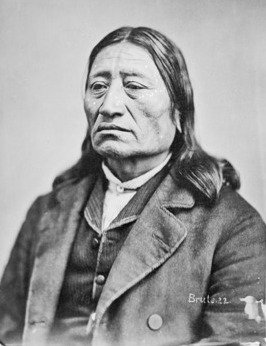Iron Nation facts for kids
Quick facts for kids
Solomon Iron Nation
|
|
|---|---|
| Ma'-Zu-Oya'-Te | |

Chief Iron Nation
|
|
| Brulé, Lakota leader | |
| Personal details | |
| Born | February 1815 |
| Died | November 15, 1894 Great Sioux Reservation |
| Cause of death | Pneumonia |
Iron Nation (born February 1815 – died November 15, 1894) was an important leader of the Lower Brulé Lakota people. He was known for signing several treaties with the United States government. These treaties helped shape the lands and rights of his people during a time of big changes.
Contents
Who Was Chief Iron Nation?
Chief Iron Nation was born in February 1815. He became a principal chief, which means a main leader, of the Lower Brulé Lakota. His Lakota name was Ma'-Zu-Oya'-Te. He worked hard to protect his people and their way of life.
Early Treaties and Land
Chief Iron Nation signed the 1851 Treaty of Fort Laramie. This was a big agreement between the U.S. government and many Native American tribes. It included the Lakota, Cheyenne, and Arapaho people. The treaty tried to set boundaries for tribal lands.
Later, on October 14, 1865, he signed another treaty at Fort Sully. This agreement was very important for his people. It officially created the Lower Brule Indian Reservation. This reservation was 20 miles long and 10 miles wide along the river.
Farming on the Reservation
The 1865 treaty also promised the Lower Brulé people $6,000 a year. Families who started farming could get an extra $25.00 bonus. In 1866, they planted crops and were surprised by a great harvest. They grew 2,000 bushels of grain! This showed how productive their new land could be.
The 1868 Treaty and the Great Sioux Reservation
Chief Iron Nation also signed the 1868 Treaty. This treaty was signed at Fort Laramie in Wyoming. It was a major victory for the Lakota people. The treaty forced the U.S. government to remove its forts along the Bozeman Trail in Montana. It also established the large Great Sioux Reservation. This reservation included a vast area of land, including the sacred Black Hills.
The Black Hills Agreement
Despite the 1868 treaty, things changed when gold was discovered in the Black Hills. This led to the Black Hills Gold Rush. Many people rushed to the area, even though the land was guaranteed to the Lakota.
In September 1876, U.S. government agents visited Native American agencies. They wanted Lakota leaders to sign away their rights to the Black Hills. The Lakota people call the Black Hills Paha Sapa, and they consider them very sacred. Chief Iron Nation signed this agreement.
Legacy of Chief Iron Nation
Chief Iron Nation passed away from pneumonia on November 15, 1894. He died at his home on the Sioux Reservation.
He is remembered as a fair and honorable leader. In 2006, he was honored by being inducted into the South Dakota Hall of Fame. His leadership helped guide his people through challenging times.
Images for kids


